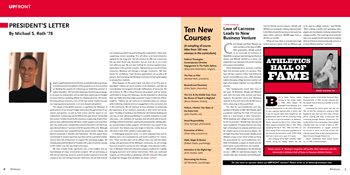PRESIDENT’S LETTER
 I spent a significant part of my first year as president planning changes to the economic foundation of the university so as to ensure that we develop the capacity for enhancing our leadership position in higher education. We have been planning a fundraising campaign to increase our endowment, and we have been examining our budget to ensure that our spending reflects our deepest priorities. Of course, the extraordinary economic crisis of the last several months has put our ongoing planning process in an even sharper perspective.
I spent a significant part of my first year as president planning changes to the economic foundation of the university so as to ensure that we develop the capacity for enhancing our leadership position in higher education. We have been planning a fundraising campaign to increase our endowment, and we have been examining our budget to ensure that our spending reflects our deepest priorities. Of course, the extraordinary economic crisis of the last several months has put our ongoing planning process in an even sharper perspective.
The impact of the global recession is significant for Wesleyan. A good portion of our annual budget comes from the generosity of our alumni and parents, as well as from tuition and the return on our endowment. Fundraising may be difficult this year, but as I’ve traveled the country I’ve been struck by the enormous outpouring of spirit from alumni who understand that Wesleyan needs support now more than ever. Our endowment, already down around 4 percent in the last fiscal year, declined about 11 percent in the first quarter of this one. Although our investments have outperformed the broad market indexes, the decline continued in October and November. We fully expect these investments to recover over time, but there will be a period of smaller returns from the endowment to support the operating budget. We recently presented the Board of Trustees with a plan to achieve savings of $15 million over the next three to five years.
We have already made significant cuts in the budget, and we have delayed all major construction projects. We are protecting as best we can teaching, research, and the student experience from the impact of our cost cutting measures. Over time, we will shift more of our fundraising efforts toward building the endowment, rather than supporting current spending. This will allow us to build economic capacity for the long term. We will continue to offer our community the very best liberal arts education, but we must do so in a more cost effective way. We are also looking for revenue opportunities, particularly in the summer months. I believe that as a result of these measures, Wesleyan will emerge a stronger institution. We have reason for confidence. Early decision applications are up about 38 percent, demonstrating that Wesleyan continues to have great appeal to prospective students.
What happens to the great hopes and plans of my first year as president? I believe we must continue to be ambitious, and that we must develop new programs through reallocations of resources. We will continue to offer a robust financial aid program, and we remain committed to hiring and retaining a faculty dedicated to advancing their own fields while they make a powerful impact on the lives of their students. I believe we can continue to internationalize our campus while furthering creativity and civic engagement in the curriculum and in the community. We will continue to focus attention on enhancing the experience of our students, especially in their frosh and senior years. The delay in building a new Molecular Life Sciences building will not stop us from advancing Wesleyan’s scientific enterprise in many other ways. I am confident, for example, that we will be able to launch a College of the Environment, and that this broad-based, interdisciplinary environmental studies program will become a key aspect of our curriculum. Our dreams may take longer to become a reality, but we will work to have them unfold in sustainable ways.
In challenging economic times, it is more important than ever to develop one’s core competencies and build a platform for innovation. These next few years will be difficult ones, but with the talent, energy, and generosity of the Wesleyan community, we will emerge from this economic turmoil an even stronger, more dynamic institution. A Wesleyan liberal arts education prepares students for a rapidly changing economic and cultural environment. With your continued support, we will provide our graduates with the resources they need to shape the changes that will define our future.
